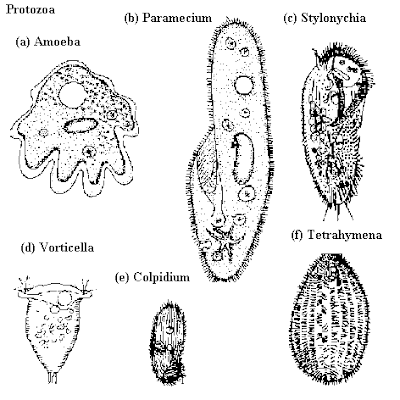a.) amoeba - cell's organelles and cytoplasm are enclosed by a cell membrane
-obtains food through phagocytosis
-heterotrophs
-single large tubular pseudopod at the anterior end
-several secondary tubular pseudopods on the sides
-about 220-740μm in length
-have at least one nuclei
-food is digested in vacuoles
-asexual
b.) paramecium - slipper shaped
-about 70 - 140 um
-covered with simple cilia
-moves about 12 body lengths per second
-heterotrophs
c.) stylonychia - has cilia grouped into membranelles along the mouth
-has cirri over the body
-long cirri at the posterior (about 3)
-carnivrous
d.)vorticella - inverted bell shape
-they are anchored onto the substrate
-live in freshwater ponds
-reproduce by budding
e. colpidium - curves left
-twist forward parallel to anterior
-swims in a spiral, rotating around their long axis
-kidney shaped
-found in moist soil
f.) tetrahymena - have two types of cell nuclei ( large and small)
-have hundreds of cilia
-complicated microbule structures
-switch from commensalistic to pathogenic modes of survival
-easy to cultivate and study

No comments:
Post a Comment